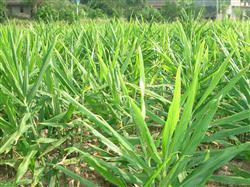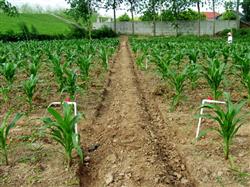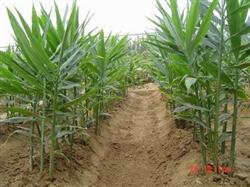High-yield cultivation techniques of interplanting watermelon with ginger

First, economic benefits: the model has been proved by many years of practice: the general output value of 667 square meters is about 8000 yuan, of which the output of ginger is 3200-4500 kg. The price is 1.60 yuan / kg, and the output value is 5100-7200 yuan. Before and after the Spring Festival, the listing price will be higher, the output value will be more; watermelon output 3000-4000 kg, listed in mid-July, the price is 0.60 yuan / kg, the output value is 1800-2400 yuan. Second, planting mode: sowing 2.3 meters, planting 4 rows of ginger, line spacing 50 cm, covering 2 meters wide, leaving a gap of 30 cm, ridging with ginger border, planting plastic film watermelon. Third, cultivation points 1, soil preparation and balanced fertilization. Choose fields with high terrain, convenient drainage and irrigation, fertile soil and no ginger planted in 3 years. New Year's Day has to dig the land deeply before. After a winter of "freezing" in the sun, it can not only freeze to death some germs and underground pests, but also deepen the plough layer, improve the physical properties of the soil, and improve the root growth environment. After the Spring Festival, the land should be carefully prepared in March, and the land should be leveled and the soil should be finely broken. Apply 5000-6000 kg of high-quality soil and miscellaneous fertilizer every 667m2, and turn it into the soil evenly combined with soil preparation. The method of balanced fertilization is as follows: ginger, the ratio of nitrogen, phosphorus and potassium is 3.5, nitrogen, phosphorus and potassium are 21 kg, 6 kg and 24 kg per 667 square meters, and ditch fertilizer is applied in the middle of two ginger seeds, 13 kg of diammonium per 667 square meters, 40 kg of potassium chloride, 23 kg of urea, 1 kg of zinc sulfate and 0.5 kg of borax. The Beginning of Autumn applied 10kg of urea, 1kg of zinc sulfate and 0.5kg of borax for every 667m2 in the ditch. In the first and middle of September, 10 kg of urea was applied every 667 square meters, and water was watered again 2 days after fertilization to ensure that chemical fertilizer was not lost. Watermelon, generally 667 square meters nitrogen 7-10 kg, phosphorus 13 kg, potassium 10 kg, base fertilizer should be strip or hole application, accounting for 60% of the total fertilizer 70%, topdressing should be hole application, accounting for 30% of the total fertilizer, accounting for 30% of the total fertilizer. 2. The selection of varieties. According to the local soil conditions, ginger tubers with no diseases and insect pests, strong growth and thick stems should be selected as seeds, such as Laiwu ginger, Taiwan fat ginger, Linquan Shitou ginger, and watermelons with high yield, high quality and early maturity. such as extra-large Hongbao, very early Milong, Jingguanlong and so on. 3. Sprouting of varieties. In early April, seed ginger is picked out from the ginger cellar. Generally, 350-450 kg of ginger is needed for every 667 square meters. Choose fat, plump, bright skin, pick out bad ginger, sun for 1-2 days, break ginger pieces for 1-2 days, and the yield of 50-75 grams of ginger is the highest. The incision should be sealed with double-effect spirit or plant ash to prevent bacteria from invading and sprouting after 2 days of sun exposure. Sprouting can be placed in the corner of the kitchen wall or in a sunny place. No matter which method of sprouting, the ginger should be covered with 10 cm thick wheat straw, and then covered with transparent film to keep warm and moisturizing. The optimum temperature for budding was 21-24 ℃. If the temperature is low, the germination is slow; if the temperature is high, the bud length is thin, which affects the yield. When the ginger buds grow to 0.5-2 cm long and 0.5-2 cm thick, they can be planted. In the middle of March, watermelons were raised in a greenhouse nutrition bowl at a germination temperature of 20-25 ℃. After transplanting, watermelons should be covered with plastic film to increase the soil temperature. 4. Planting method. Ginger is sown in trenches with a distance of 50 cm, a depth of 15 cm and a plant spacing of about 15 cm. 7000-9000 plants are planted every 667m2. The seeds should be soaked in carbendazim solution for about 30 minutes before sowing. Pour water through the bottom of the ditch, and then place the ginger flat at the bottom of the ditch, so that the seed buds are inclined upward and placed in one direction. Drop the pre-mixed compound fertilizer between the two ginger trees and cover it with fine soil 4-5 cm thick. Watermelon planting, first make a 30 cm wide ridge, watermelon seedlings transplanted on the ridge, plant spacing of about 40 cm, the mixed compound fertilizer hole in the middle of the two melon seedlings, and then covered with plastic film. If there are conditions, you can use a small bow shed. This can advance the growth period of watermelon and shorten the symbiotic period of watermelon and ginger. 5. Chemical weeding. 2-5 days after planting, ginger is sprayed with 200 grams of Lasol and 50 kilograms of water for every 667 square meters, and the weeding effect is still more than 90% after 1 month. Herbicide, trifluralin and aminophos can also be sprayed before planting to ensure the safety of ginger seedlings. Watermelons can be transplanted after spraying herbicides. 6. Prevent diseases and insects. The incidence period of ginger leaf blight is the most in August. before the disease season and at the initial stage of the disease, the ginger leaf blight can be sprayed with 150-fold Bordeaux liquid for 2-3 times, or 800-fold solution of carbendazim. It also has a good control effect on anthracnose and Fusarium wilt of watermelon. Ginger blast is caused by Pseudomonas solanacearum, which occurs quickly in high temperature season and is difficult to control after the disease, so it should be prevented and treated early. When the disease occurs, it is effective to irrigate the root with 160 times of 40% Dysenamine solution, and it can be prevented by spraying 40% Dysenamine 600 times solution in the onset season. Generally every 7 days spray; ginger, commonly known as chopper, before the 3rd instar with 50% methamidophos or 90% trichlorfon 1000 times liquid spray, focus on spraying heart leaves, spray in insect hours, to spray once in 10-15 days, so on watermelon seedlings aphids, Huangshou melon have a good control effect. 7. Field management of watermelon. In the seedling stage of watermelon, due to the low temperature at that time, the ground temperature should be increased as much as possible to promote the root system to grow early and grow quickly. The aboveground parts should be strictly protected and it is very important to protect the leaves. In the plant growth, in the case of leaving 1 melon per plant, the first female flower is not left, but the second female flower or the third female flower is mostly selected. In the young melon stage, a melon with a normal shape should be selected, and the rest of the young melons should be thinned out to ensure that the selected young melons expand rapidly. After seedling transplanting, it is necessary to water as little or no water as possible to promote the seedling to form a developed root system; with the growth of the plant, the water demand of watermelon increases gradually, generally before flowering and fruit setting, but also to control water to prevent crazy growth. When setting fruit, adequate water supply should be ensured to facilitate fruit expansion and increase weight. It is not suitable to water the fruit 7-10 days before harvest, so that the fruit can accumulate sugar, so that good quality and large fruit can be obtained.
- Prev

Cultivation techniques of interplanting Maize with Ginger
Ginger belongs to shade-tolerant crops, and high temperature and strong light are disadvantageous to its growth. interplanting high-stem crops in ginger fields can make full use of the three-dimensional space of high and low crops, provide shading for ginger, improve the utilization rate of light energy, and improve the utilization rate of land. increase yield per unit area. It does not affect the output and quality of ginger.
- Next

Cultivation techniques of Ginger softening
The softening cultivation of ginger is on the basis of normal cultivation, one is to increase the cultivation density and strengthen the measures of shading and cooling, so as to achieve the purpose of harvesting tender ginger. In this way, tender ginger not only has a long harvest time, high yield, but also fresh and crisp, thin skin and sparse skin, and has a delicate ginger flavor when eating. 1. Choose: choose those who have not planted ginger for 3 years in a row.
Related
- Where is it suitable to grow horseradish in China? it is expected to see the middle altitude horseradish in Alishan.
- How to prevent tomato virus disease reasonably? (Control methods included)
- Many people like to plant towel gourd on the balcony. What are the main points of this method and management?
- What crops can chili peppers be mixed with?
- Fertilization techniques and matters needing attention in Tomato
- What are the grafting techniques for peach seedlings in spring?
- Harm and control methods of root swelling disease of Chinese cabbage
- What are the pests of sweet potatoes? How to prevent and cure it?
- Symptoms, causes and Control methods of navel Rot in Tomato
- The cause of "Cucumber rotten bibcock" in Farmers' planting Cucumber and its Control Plan

